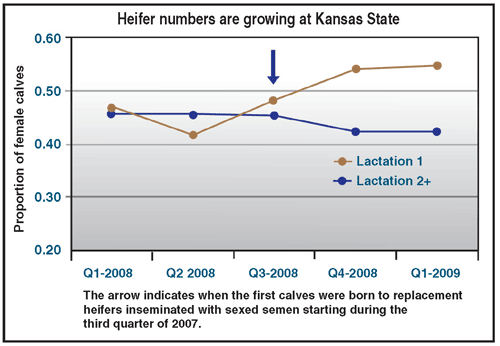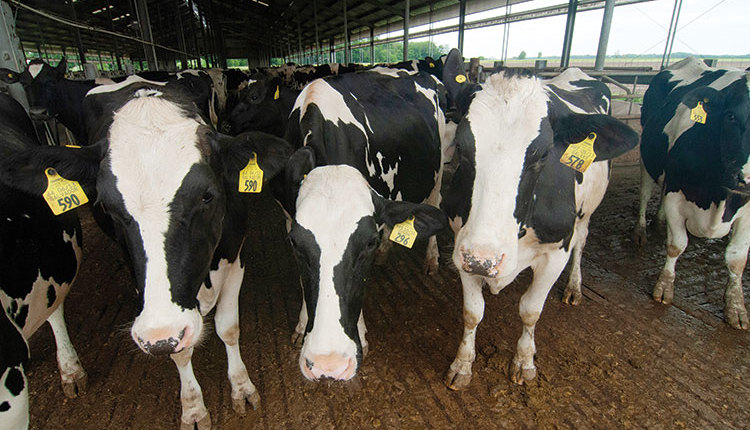The author is professor of animal sciences at Kansas State University, Manhattan.
In the 1980s, a breakthrough in semen sexing technology was made by USDA researchers in the Lawrence Livermore Laboratory in California. The patents for this technology were licensed to a company named XY, Inc., of Fort Collins, Colo., which performed a considerable amount of research during the 1990s to optimize sorting procedures efficiency. The first commercial product hit the market in 2003 when Sexing Technologies in Navasota, Texas, was granted a license. Most of the major bull studs now have sexed semen for sale. Let's look at some of the advantages of applying sexed semen in your replacement heifers.
According to the field data that has been gathered, conception rates of replacement heifers inseminated with sexed semen run about 70 to 80 percent of what you have been achieving with conventional semen, with about 80 to 90 percent of the offspring being heifers. A recent report of conception rates of Holstein heifers from 54 herds in which more than 50 inseminations were made using both conventional and sexed semen is shown in Table 1.

The analysis of on-farm records in Table 1 indicates sexed semen achieves conception rates that are about 80 percent of that obtained with conventional semen. However, these results are likely biased by preferential use of sexed semen at first service, and the product is often used on heifers displaying definitive signs of estrus. These results should be interpreted with caution. This bias is also reflected in younger age at A.I., younger age at calving, and perhaps by a greater incidence of normal interestrus intervals for females inseminated with sexed semen compared with conventional semen.
Approximately 80 to 90 percent of the offspring reported from use of sexed semen in Table 1 were female. Based on our use of sexed semen in heifers at the Kansas State University dairy since the third quarter of 2007, we have seen a steady increase in the proportion of heifers born to replacement heifers (first-lactation cows in the figure) starting during the beginning of the third quarter in 2008. We are generally using sexed semen for the first three A.I. services of our heifers. See the graph.

So the percentage of heifers giving birth to heifers should increase, depending on the proportion of females currently born in your herd. According to Table 2, the predicted proportion of heifers born in your herd should grow with time after you have used sexed semen for about 18 to 24 months. That allows 9 to 12 months of A.I. breeding with sexed semen and 9 months of calves resulting from those inseminations.
Remember that DHI records are likely summarizing birth inventory on a rolling 365-day basis, so you'll need a full year of calving data before you'll realize the full benefit of using sexed semen in your heifers. Herds having a greater culling rate will have more first-lactation cows in their herd inventory. So more and more of your total calf inventory will come from your replacement herd. The nice bonus of applying sexed semen to your replacement heifers means that you should be able to grow your herd if desired or, depending on your culling rate, you may have extra heifers to sell.
Sex-sorted semen is a novel technology that has been widely and rapidly adopted by dairy producers to boost the percentage of heifers born and to capitalize on associated benefits. Another, often cited advantage is many first-calf heifers enter the milking string with less calving-related stress. It is often large bull calves that set first calvers back in early lactation. More heifers often leads to a reduction in difficult births.
Preferential use of sexed semen dictates that caution should be exercised when summarizing, analyzing, and comparing fertility and calving data of sexed and conventional semen in both on-farm and population analyses.
Click here to return to the Reproduction E-Sources
090410_272
Conception rates . . .
According to the field data that has been gathered, conception rates of replacement heifers inseminated with sexed semen run about 70 to 80 percent of what you have been achieving with conventional semen, with about 80 to 90 percent of the offspring being heifers. A recent report of conception rates of Holstein heifers from 54 herds in which more than 50 inseminations were made using both conventional and sexed semen is shown in Table 1.

The analysis of on-farm records in Table 1 indicates sexed semen achieves conception rates that are about 80 percent of that obtained with conventional semen. However, these results are likely biased by preferential use of sexed semen at first service, and the product is often used on heifers displaying definitive signs of estrus. These results should be interpreted with caution. This bias is also reflected in younger age at A.I., younger age at calving, and perhaps by a greater incidence of normal interestrus intervals for females inseminated with sexed semen compared with conventional semen.
Approximately 80 to 90 percent of the offspring reported from use of sexed semen in Table 1 were female. Based on our use of sexed semen in heifers at the Kansas State University dairy since the third quarter of 2007, we have seen a steady increase in the proportion of heifers born to replacement heifers (first-lactation cows in the figure) starting during the beginning of the third quarter in 2008. We are generally using sexed semen for the first three A.I. services of our heifers. See the graph.

So the percentage of heifers giving birth to heifers should increase, depending on the proportion of females currently born in your herd. According to Table 2, the predicted proportion of heifers born in your herd should grow with time after you have used sexed semen for about 18 to 24 months. That allows 9 to 12 months of A.I. breeding with sexed semen and 9 months of calves resulting from those inseminations.
Remember that DHI records are likely summarizing birth inventory on a rolling 365-day basis, so you'll need a full year of calving data before you'll realize the full benefit of using sexed semen in your heifers. Herds having a greater culling rate will have more first-lactation cows in their herd inventory. So more and more of your total calf inventory will come from your replacement herd. The nice bonus of applying sexed semen to your replacement heifers means that you should be able to grow your herd if desired or, depending on your culling rate, you may have extra heifers to sell.
Sex-sorted semen is a novel technology that has been widely and rapidly adopted by dairy producers to boost the percentage of heifers born and to capitalize on associated benefits. Another, often cited advantage is many first-calf heifers enter the milking string with less calving-related stress. It is often large bull calves that set first calvers back in early lactation. More heifers often leads to a reduction in difficult births.
Preferential use of sexed semen dictates that caution should be exercised when summarizing, analyzing, and comparing fertility and calving data of sexed and conventional semen in both on-farm and population analyses.
090410_272










